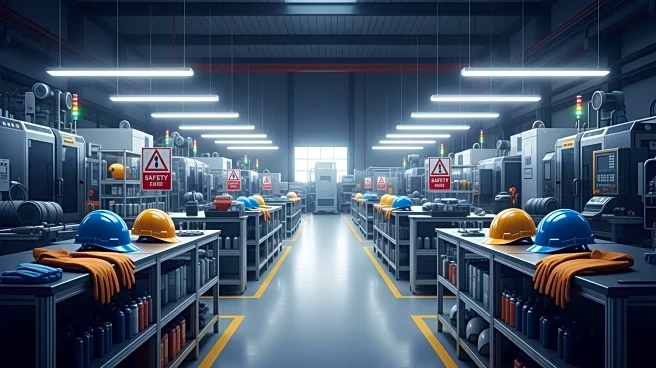What's Happening?
Manufacturers are increasingly recognizing the importance of maintaining robust safety measures as a competitive advantage, especially in the face of economic volatility and workplace deregulation. The
U.S. Department of Labor has proposed changes that could reduce regulatory oversight, prompting manufacturers to take proactive steps in ensuring workplace safety. Despite the temptation to cut costs, data from the American Society of Safety Professionals indicates that every dollar spent on safety can yield significant savings, ranging from $2 to $6. This is due to the reduction in direct costs such as medical expenses and equipment repairs, as well as hidden costs like lost productivity and increased insurance premiums. As deregulation progresses, manufacturers are faced with the choice of either waiting for regulatory intervention or proactively building a culture of safety that enhances resilience and agility.
Why It's Important?
The shift towards a safety-centric culture is crucial for manufacturers aiming to maintain productivity and profitability in uncertain economic times. By investing in safety, companies can mitigate the risks associated with workplace incidents, which can lead to substantial financial losses. Furthermore, a strong safety culture supports the recruitment and retention of top talent, particularly among younger generations who prioritize psychological safety and empathetic leadership. As manufacturing employment faces challenges, with millions of jobs projected to remain unfilled, fostering a safe and supportive work environment becomes essential for attracting and retaining skilled workers. This approach not only enhances employee engagement and productivity but also aligns company values with the expectations of Gen Z and millennials.
What's Next?
Manufacturers are likely to continue prioritizing safety as a strategic advantage, especially as deregulation efforts unfold. Companies may increasingly adopt proactive safety measures that empower employees to identify and report risks, thereby enhancing workplace resilience. This focus on safety could lead to a shift from compliance-driven practices to excellence-driven initiatives, fostering a culture that supports long-term business success. As the national debate on workplace regulations continues, manufacturers will need to navigate these changes carefully, balancing flexibility with the need to protect their workforce and maintain operational efficiency.
Beyond the Headlines
The emphasis on safety culture extends beyond immediate financial benefits, touching on ethical and cultural dimensions within the workplace. By prioritizing safety, manufacturers demonstrate a commitment to employee well-being, which can enhance corporate reputation and stakeholder trust. This approach also reflects broader societal shifts towards valuing mental and emotional health, as companies strive to create environments where employees feel secure and valued. In the long term, a strong safety culture can contribute to sustainable business practices and resilience in the face of external challenges.











